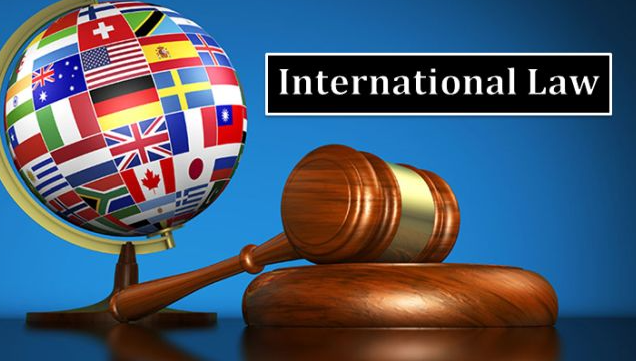The history of international law is a riveting narrative that unfolds across centuries, encapsulating the dynamic interplay of power, diplomacy, and ethical considerations in the realm of global relations. From its nascent origins to the sophisticated system that governs our interconnected world today, the history of international law is marked by key developments that have shaped the conduct of states and individuals on the international stage.
Ancient Roots of International Law: The seeds of international law can be traced back to the ancient world, where city-states in Ancient Greece and Rome established codes of conduct governing their interactions. Treaties and agreements between empires and kingdoms laid the groundwork for early principles of diplomacy and respect for territorial sovereignty.
Medieval and Renaissance Influences: The medieval period witnessed the influence of Catholic canon law on the development of norms guiding international relations. However, it was the Peace of Westphalia in 1648 that signalled a pivotal moment, solidifying the concept of state sovereignty and laying the foundation for the modern state system.
The Birth of Modern International Law: The Enlightenment era brought forth legal scholars like Hugo Grotius and Emer de Vattel, who contributed significantly to the conceptualization of international law. Treaties such as the Treaty of Utrecht (1713) and the Congress of Vienna (1815) further shaped the principles that underpin the relations between sovereign states.
Humanitarian Law and the Laws of War: As conflicts became more prevalent, the need to regulate armed conflict and protect the rights of individuals in times of war became apparent. The development of humanitarian law, exemplified by the Geneva Conventions, and the establishment of the International Committee of the Red Cross marked crucial steps in this direction.
The League of Nations and the United Nations: The aftermath of World War I saw the creation of the League of Nations, the first international organization aimed at maintaining peace and preventing conflicts. Despite its shortcomings, the League paved the way for the establishment of the United Nations in 1945, solidifying the commitment to international cooperation and the codification of laws governing state behaviour.
Post-Cold War Era: The end of the Cold War ushered in a new era for international law. The focus shifted to addressing human rights violations, environmental concerns, and the establishment of international criminal tribunals to prosecute war crimes and crimes against humanity. This period saw the maturation of the global legal framework to adapt to the changing geopolitical landscape.
Contemporary Issues and Challenges: In the contemporary landscape, international law faces an array of challenges. Debates over state sovereignty, the role of non-state actors, and the implications of technological advancements on traditional legal frameworks are reshaping the discourse. Emerging areas like cyber law and space law underscore the need for a dynamic and adaptable international legal system.
The Future of International Law: As we stand at the threshold of the future, the trajectory of international law remains uncertain yet promising. The continued evolution of the global landscape, coupled with the imperative for international cooperation in addressing existential challenges, necessitates ongoing adaptation and reform within the realm of international law. The potential for innovation, coupled with the resilience of established principles, will shape the future of this intricate and vital legal framework.
Contents
The Struggle for Justice: A Closer Look at Key Milestones
Throughout its history, international law has been shaped by critical milestones that reflect the ongoing struggle for justice, peace, and the protection of fundamental human rights.
1. Versailles Treaty (1919): The aftermath of World War I marked a turning point in international law with the signing of the Versailles Treaty. The treaty not only redefined the borders of nations but also introduced the concept of war guilt and reparations. Despite its controversial legacy, the treaty set a precedent for holding states accountable for their actions on the global stage.
2. Nuremberg Trials (1945-1946): In the wake of World War II, the Nuremberg Trials represented a watershed moment in the history of international law. For the first time, political and military leaders were held accountable for crimes against humanity, establishing the principle that individuals could be prosecuted for international crimes. This laid the groundwork for subsequent international criminal tribunals.
3. Universal Declaration of Human Rights (1948): The adoption of the Universal Declaration of Human Rights by the United Nations General Assembly in 1948 was a monumental achievement. This foundational document proclaimed the inalienable rights to which all human beings are entitled, regardless of nationality, ethnicity, or religion. It set the stage for the development of international human rights law.
4. Genocide Convention (1948) and Geneva Conventions (1949): The post-World War II era saw the codification of laws specifically addressing atrocities and armed conflicts. The Genocide Convention and the four Geneva Conventions established legal frameworks for preventing and punishing genocide and protecting civilians, prisoners of war, and the wounded in times of armed conflict.
5. Cold War and Diplomatic Initiatives: The Cold War era presented challenges to international law as ideological tensions strained diplomatic relations. However, noteworthy initiatives, such as arms control treaties and efforts to prevent the spread of nuclear weapons, demonstrated the international community’s commitment to finding legal mechanisms to manage global challenges.
6. International Criminal Court (ICC) (1998): The establishment of the International Criminal Court in 1998 marked a significant step forward in the fight against impunity. The ICC became the first permanent international court with the mandate to prosecute individuals for the most serious crimes of international concern, including genocide, war crimes, and crimes against humanity.
7. Paris Agreement (2015): In response to the escalating threat of climate change, the Paris Agreement stands as a landmark in international environmental law. Signed by nearly all nations, the agreement represents a collective commitment to limit global temperature increases and mitigate the impacts of climate change, showcasing the evolving role of international law in addressing pressing global challenges.
8. Cybersecurity and Space Law: As technology continues to advance, international law is grappling with new frontiers. The rise of cyber threats and the increasing militarization of space pose novel challenges that necessitate the development of legal frameworks to govern these domains and ensure the responsible use of technology on the global stage.
Conclusion
The history of international law is not a static narrative but an ongoing story of adaptation, progress, and the collective effort to address the complexities of a changing world. From ancient codes of conduct to modern treaties and conventions, the evolution of international law reflects humanity’s commitment to creating a more just and peaceful global order. As we navigate the future, the lessons of the past serve as guideposts, reminding us of the ongoing imperative to forge a legal framework that promotes cooperation, justice, and the well-being of all nations and individuals on our shared planet.


Leave a Reply